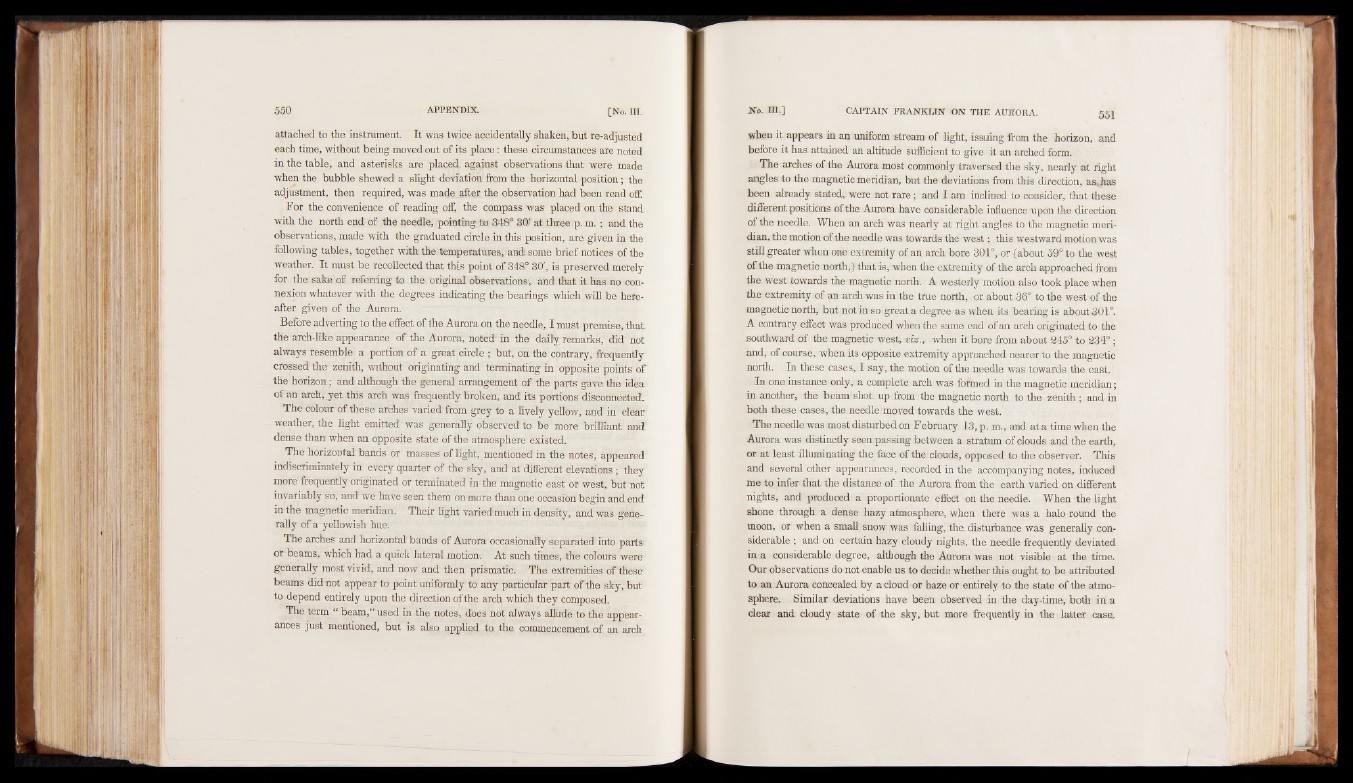
attached to the instrument. It was twice accidentally shaken, but re-adjusted
each time, without being moved out of its place: these circumstances are noted
in the table, and asterisks are placed, against observations that were made
when the bubble shewed a slight deviation from the horizontal position; the
adjustment, then required, was made after the observation had been read off.
For the convenience of reading off, the compass was placed on the stand
with the north end of the needle, pointing to' 348° 30 at three p. m. ; and the
observations, made with the graduated circle in this position, are given in the'
following tables, together with the temperatures, and some brief notices of the
weather. It must be recollected that this point of 348° 30', is preserved merely
for the sake of referring to the original observations^, and that it has. no connexion
whatever with the degrees indicating the bearings which will be hereafter
given of the Aurora.
Before adverting to the effect of the Aurora on the needle, I must premise, that
the arch-like appearance of the Aurora, noted in the daily remarks, did not
always resemble a portion ofa great circle ; but, on the contrary, frequently
crossed the zenith, without originating and terminating in opposite points of'
the horizon; and although the general arrangement of the parts gave the idea
of an arch, yet this arch was frequently broken, and its portions disconnected'.
The colour of these arches varied from grey to a lively yellow, and in clear
weather, the light emitted was generally observed to be more brilliant and
dense than when an opposite state of the atmosphere existed.
The horizontal bands or masses of light, mentioned in the notes, appeared
indiscriminately in- every quarter of the sky, and at different elevations ; they
more frequently originated or terminated in the magnetic east of west, but not
invariably so, and we have seen them on more than one occasion begin and end
in the magnetic meridian. Their light varied much in rally of a yellowish hue. density , and was geneThe
arches and horizontal bands of Aurora occasionally separated into parts
or beams, which had a quick lateral motion. At such times, the colours were
generally most vivid, and now and' then prismatic. The extremities of these
beams did not appear to point uniformly to any particular part- of the sky, but
to depend entirely upon the direction of the arch which they composed.
The term “ beam,” used'in the notes, does not always allude to the appearances
just mentioned, but is also applied to the. commencement of an arch
when it appears in an uniform stream Df light, issuing from the horizon, and
before it has attained an altitude sufficient to give it an arched form.
The arches of the Aurora most commonly traversed the sky, nearly at right
angles to the magnetic meridian, but the deviations from this direction, asjias
heen already stated, were not rare; and I am inclined to consider, that these
different positions of the Aurora have considerable influence upon the direction
of the needle. When an arch was nearly at right angles to the magnetic meridian,
the motion of the needle was towards the west; this westward motion Was
Still greater when one extremity of an arch bore 301°, or (about 59° to the west
of the magnetic north,) that is, when the extremity of the arch approached from
the west towards the magnetic north. A westerly motion also took place when
the extremity of an arch was in the true north, or about 36° to the west of the
magnetic north, but not in so great a degree as when its bearing is about 301°.
A contrary effect was produced when the same end of an arch originated to the
southward of the magnetic west, viz., when it bore from about 245° to 234° ;
and, of course, when its opposite extremity approached nearer to the magnetic
north. In these cases, I say, the motion of the needle was towards the east.
In one instance only, a complete arch was formed in the magnetic meridian;
in another, the beam shot up from the magnetic north to the zenith ; and in
both these cases, the needle moved towards the west.
The needle was most disturbed on F ebruary 13, p. m.-, and at a time when the
Aurora was distinctly seen passing between a stratum of clouds and the earth,
or at least illuminating the face of the clouds, opposed to the observer. This
and several other appearances, Tecorded in the accompanying notes, induced
me to infer that the distance of the Aurora from the earth varied on different
nights, and produced a proportionate effect on the needle. When the light
shone through a dense hazy atmosphere, when there was a halo round the
moon, or when a small snow was falling, the disturbance was generally considerable
; and on certain hazy cloudy nights, the needle frequently deviated
in a considerable degree, although the Aurora was not visible at the time.
Our observations do not enable us to decide whether this ought to be attributed
to an Aurora concealed by a cloud or haze or entirely to the state of the atmosphere.
Similar deviations have been observed in the day-time, both in a
dear and doudy state of the sky, but more frequently in the latter case.